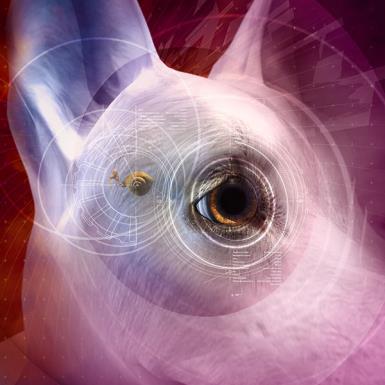Eye disorders and diseases are evaluated and treated by veterinary ophthalmologists. Many systemic disorders also affect the eyes, so careful evaluation may alert the clinician to their presence. Ear conditions include infectious, neoplastic, and inflammatory disorders.
Eye and Ear

-
Ophthalmology
-
Chlamydial Conjunctivitis
-
Equine Recurrent Uveitis
-
Eyeworm Disease
-
Infectious Keratoconjunctivitis
-
Neoplasia of the Eye and Associated Structures
-
Deafness
-
Diseases of the Pinna
- Overview of Diseases of the Pinna
- Arthropod Bite Pinnal Dermatitis
- Insect Bite Dermatitis
- Mite Infestations
- Allergy
- Aural Contact Dermatitis
- Pinnal Alopecia
- Ear Margin Seborrhea
- Sebaceous Adenitis
- Auricular Hematomas
- Equine Aural Plaques
-
Necrotic Ear Syndrome in Swine
- Miscellaneous Diseases of the Pinna
-
Otitis Externa
-
Otitis Media and Interna
-
Tumors of the Ear Canal
Eye and Ear Sections (A-Z)
Chlamydial Conjunctivitis
Deafness
Diseases of the Pinna
A variety of dermatologic conditions affect the pinna. Rarely, a disease affects the pinna alone or the pinna is the initial site affected. As with all dermatologic conditions, a diagnosis is best made with the results of a thorough history, a complete physical and dermatologic examination, and with careful selection and evaluation of specific diagnostic tests. This overview is not all inclusive but discusses diseases that solely or commonly affect the pinna of domestic animals.
Equine Recurrent Uveitis
Equine recurrent uveitis (ERU) is an important ophthalmic condition with a reported prevalence of 2%–25% worldwide. The classic form of ERU is characterized by episodes of active intraocular inflammation followed by variable quiescent periods. However, some horses experience insidious ERU in which subclinical ocular inflammation persists without obvious signs of discomfort. With chronicity, the inflammatory bouts cause secondary ocular changes such as cataracts, lens luxation, glaucoma, phthisis bulbi, and retinal degeneration. As a result, ERU is the most common cause of blindness in horses in the world.
Eyeworm Disease
Thelazia californiensis is found in dogs, cats, and deer in western USA; T callipaeda is found in dogs, cats, foxes, wolves, martens, and rabbits in Europe and Asia. T callipaeda appears to be spreading in some regions of Europe. Both species are zoonotic. The worms are whitish, 7–19 mm long, and move in a rapid serpentine motion across the eye. Up to 100 eyeworms may be seen in the conjunctival sac, tear ducts, and on the conjunctiva under the nictitating membrane and eyelids. Filth flies (Musca spp, Fannia spp) serve as intermediate hosts and deposit infective larvae on the eye while feeding on ocular secretions. Zoophilic fruit flies have emerged as potential intermediate hosts of T callipaeda. These include Phortica variegata in Europe and Amiota spp in Asia.
Infectious Keratoconjunctivitis
Neoplasia of the Eye and Associated Structures
Ophthalmology
The initial examination of the eye should assess symmetry, conformation, and gross lesions; the eye should be viewed from 2–3 ft (~1 m) away, in good light, and with minimal restraint of the head. The anterior ocular segment and pupillary light reflexes are examined in detail with a strong light and under magnification in a darkened room. Baseline tests like the Schirmer tear test, fluorescein staining, and tonometry (intraocular pressure measurement) may be followed by ancillary tests such as taking corneal and conjunctival cytology and cultures, everting the eyelids for examination, and flushing the nasolacrimal system to evaluate the external parts of the eye, including the anterior segment. Diseases of the vitreous and ocular fundus are evaluated by direct and indirect ophthalmoscopy (usually performed after inducing mydriasis) and vision testing (menace reflex, obstacle course, dazzle reflex, etc).
Otitis Externa
Otitis externa is inflammation of the external ear canal distal to the tympanic membrane; the ear pinna may or may not be involved. It may be acute or chronic and unilateral or bilateral. It is one of the most common reasons for small animals to be presented to the veterinarian. Clinical signs can include any combination of headshaking, odor, pain on manipulation of the ear, exudate, and erythema. It can be seen in rabbits (in which it is usually due to the mite Psoroptes cuniculi) and is uncommon in large animals.
Otitis Media and Interna
Otitis media, inflammation of the middle ear structures, is seen in small and large domestic animals, including dogs, cats, rabbits, ruminants, horses, pigs, and camelids. It can be unilateral or bilateral and can affect animals of all ages. Although typically sporadic, outbreaks are possible in herds. Otitis media usually results from extension of infection from the external ear canal through the tympanic membrane or from migration of pharyngeal microorganisms through the auditory tube. Occasionally, infection extends from the inner ear to the middle ear, or reaches the middle ear by the hematogenous route. Primary otitis media has been reported in certain breeds of dogs, particularly Cavalier King Charles Spaniels. Untreated otitis media can lead to otitis interna (inflammation of the inner ear structures) or to rupture of an intact tympanic membrane with subsequent otorrhea or otitis externa.
Tumors of the Ear Canal
Also of Interest
Test your knowledge
Which of the following cleaning agents is contraindicated in a patient with otitis externa and a ruptured tympanic membrane?




